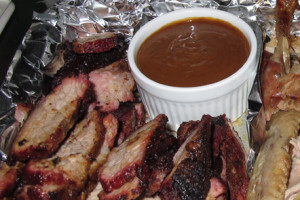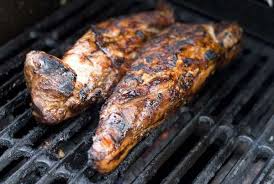“But I want to barbecue something quick!” Much like honesty in politics, fast barbecue is one of life’s little unicorns. It doesn’t exist no matter how much we all want it to.
Or does it?
By its nature, real barbecue cooking is low and slow with smoke. That’s just how it is, son. You can’t rush the stuff; it’s done when it’s done and not a minute before. It’s like the speed of light; an absolute that can’t be broken. But you can cheat the laws of physics if you know a little culinary lawyering (or the chief engineer of the USS Enterprise).

Smaller cuts of meat are a favorite of mine when I don’t have the time for something big but still have the craving. I can’t magically smoke a 15 lb beef brisket to perfection in four hours (screwing it up in that time is another story). However, I can satisfy my need for barbecue beef in that shorter span by using a smaller cut of cow, like a tri-tip roast. In the mood for pulled pork but don’t have all day to babysit a big ol’ pork butt? Bust out a smaller package of pork cushion meat instead. Smaller cuts cook faster and are also ideal when you’re only cooking for a few people.
The same rules apply to the mini-cuts as their larger cousins. Same internal temp, same heat, same smoke, same rub… you get the idea. That helps a lot not just with time management but also for practicing your pitmaster kung fu, experimenting with new flavors, and flexibility during a cook in the backyard.
Practice makes perfect; theoretically, the more you do something the better you get as you go. You learn what works and what doesn’t. Most of us don’t have the time or budget to barbecue big cuts of meat every night of the week, relegating our pitmaster training to every weekend, if we’re lucky. If I use smaller cuts of pork each night for a week (or divide up a large one into portions), I’ve now barbecued five to seven nights in a row, making corrections along the way. The same holds true for beef, although I can’t see myself doing that to a brisket. Tri-tip roasts only weigh a few pounds, however, and taste great in their own right. The only drawback I can see here is eating the same barbecue every night for a week, if you can call that a problem. No, I can’t either.
Even if you thought flavor numbness would be an issue, change up the flavor profile each night or alternate between meats. Spicy Jamaican pork Monday, barbecue beef Tuesday, and so forth. Be sure to tailor the size of the victim cut of meat to fit within your available time, though. This isn’t so much an issue for single folk but if you’ve got a nestful of hungry gremlins chirping for grub every night, you’ll have to get creative to make this plan work on weeknights. Doing this every night of the month might burn you out but that’s true of doing almost anything.
The smaller cuts approach works well on weekends also. Sometimes I’ve found it to be even better in some situations. It gives you flexibility; my four-rack upright smoker will hold a lot of meat for a normal backyard barbecue. Filling it with a variety of smaller cuts instead of one big chunk of one beast lets me offer up pork, beef, and chicken at the same time, if I plan properly. That gives my guests variety and options that are all ready to eat when they are.
It’s not the full rainbow of chowing down that you’d get with barbecued unicorn, but nobody’s perfect.
- 1 3.5-5 lb tri-tip roast, trimmed
- 1 tbsp salt
- 1 tsp chile powder
- 1 tbsp crushed balck pepper
- 1 tbsp cumin
- 1 tbsp ground habanero chile
- 1 tbsp garlic powder
- Mix all the spices in a bowl and spread the mixture evenly on a cutting board. Gently coat both sides of the tri-tip in the mixture.
- Barbecue the tri-tip until it reaches an internal temperature of 145 F at its thickest point (about 2-3 hours).
- Let it rest for 20 minutes, then slice against the grain and serve.
Latest posts by Mark Masker (see all)
- 2024 Scovie Awards Call for Entries - 07/07/2023
- 2024 Scovie Awards Early Bird Special: 3 Days Left - 06/29/2023
- 2024 Scovie Awards Early Bird Deadline Looms - 06/25/2023









